| Find in this manual | ||
| Replace with | ||
Historical Leagues are based on historical Major League Baseball data, and are most commonly used by players who prefer to do historical simulations. See League Types for more information on Historical Leagues. For more detail on any of the historical options in the wizard, see the manual screen about setting up historical leagues in advanced mode.
Step 1 - Historical Import Settings
In Step 1 of the Historical League Creation Wizard, you tell OOTP where to find your historical database, define which historical year you want to play, and set a number of factors that impact the ratings of imported players.
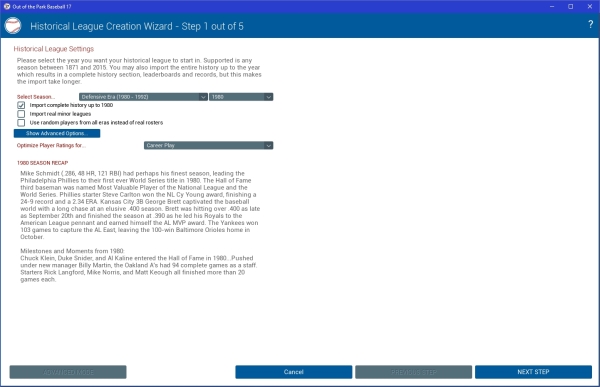
First, choose the season you wish to begin with. Seasons are grouped into eras based on similarities in styles of play, such as the Deadball Era or Modern Times. When you choose a season, a recap of the season will appear below the selected year.
Use the Import complete history check box to indicate whether or not you want to import the complete history prior to the selected year. For example, if you select 1977 and check the box, your leaderboards will appear exactly as the leaderboards appeared in 1977. If you do not select the check box, it will be as if your league had no history prior to 1977. (Importing the full history can take some time on slower machines.)
You can also choose to randomly select players from any era, rather than using the actual historical rosters from that season. If you activate this option, you'll see an additional menu that allows you to specify a minimum and maximum year that the random players can be chosen from.
Next, choose how OOTP should optimize player ratings. You can optimize for career play or for single-season replay. If you're interested in starting in a certain year and playing forward for many years, choose "Career Play." If you just want to do a replay of a single season, choose "Single-Season Replay."
If you would like greater control over the way OOTP handles your historical league, click the Show Advanced Options button to see more detailed settings:

| Option | Description |
| Select Path to Database | Browse to find the path where the historical database you wish to use is located. Locate the primary database file for your historical database. To use either one of the two built-in historical databases provided by OOTP (Lahman, or stat-neutralized Lahman), choose the file historical_database.odb. In default installations, this file can be found in OOTP Baseball/stats directory. This should be the default directory on this screen, so in all likelihood you're already in the right place. If you are using another historical database, you should select the file from that database called master.csv. |
| Base Current Ratings on... | This option basically allows you to choose between the pure Lahman statistical database, and Garlon and Spritze's neutralized database. There are two options in this drop-down, used to determine the current ratings assigned to imported players.
|
| Base Potential Ratings on... | There are four options in this drop-down, used to determine the potential ratings assigned to imported players.
If the "Recalc player ratings based on real stats after each year" option is chosen on the Historical Settings screen, then it overrides the potential ratings calculation method chosen above. |
| Base Fielding Ratings on... | This option allows you to base the fielding ratings of imported players on the selected season, a three-year period, or the player's entire career. |
| Base Pitcher Stamina Ratings on... | This option allows you to base the pitcher stamina ratings of imported players on the selected season, a three-year period, or the player's entire career. |
| Generate random L/R splits | Historical databases do not usually include data on how hitters performed specifically against right-handed or left-handed pitchers. If you select this option, a right-handed hitter will generally have better ratings against a left-handed pitcher. If you leave this unchecked, players will generally hit equally against all pitchers. |
| Adjust Hitters with Fewer than X At-Bats | This setting forces the game to adjust the batting ratings for players who did not play very much in the selected season. For example, this would prevent a player who hit .500, but in limited at-bats, from being rated very highly by making them closer to the league average. By default, players with fewer than 200 at-bats will be adjusted. |
| Weaken Hitters with Fewer than X At-Bats | Similar to the prior setting, this setting forces the game to severely reduce the batting ratings for players who had a very low number of at-bats in the selected season, reducing their hits, HRs, etc. By default this is set to 50 at-bats. |
| Adjust Pitchers with Fewer than X Innings | This setting forces the game to adjust the pitching ratings for players who did not play very much in the selected season. For example, this would prevent a player who pitched well, but in just 5 innings of play, from being rated very highly by making them closer to the league average. By default, players with fewer than 25 innings pitched will be adjusted. The game will multiply the entered IP by four when adjusting starting pitchers. |
| Weaken Pitchers with Fewer than X Innings | Similar to the prior setting, this setting forces the game to severely reduce the pitching ratings for players who had a very low number of innings pitched in the selected season, reducing strikeouts, etc. By default this is set to 10 innings. The game will multiply the entered IP by four when adjusting starting pitchers. |
When you are done, click Next Step.
Step 2 - Transactions, Minor Leagues, and Roster Settings
In Step 2 of the Historical League Creation Wizard, you define your transactions, minor leagues and some roster settings.
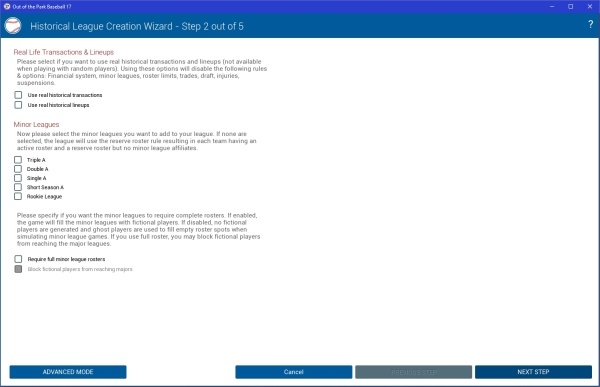
In the first section of this step, you can decide whether or you want OOTP to use real historical transactions. if you choose this, OOTP will replicate transactions as they occurred in real life. If you have enabled this option, you can also choose whether or not you want OOTP to use the actual historical lineups from each game.
Check the box for each level of minor leagues that you want to have in your league. If you choose not to have minor leagues, your league will use a reserve roster. The Historical Wizard only offers 5 levels of minor leagues, but OOTP can create any kind of custom minor league structure. If you want to have a more complicated minor league structure, such as one in which there are multiple leagues at Triple-A level, you can drop into Advanced Mode.
For the bottom part of the page, decide whether you would like to require full minor league rosters. If you do require full rosters, most historical databases do not have enough information about minor leaguers to fill all roster spots. Therefore, the game will create fictional players to fill those slots. If you choose this option, you will also have the ability to block these fictional players from ever reaching the major leagues. Many historical OOTP players do this so that fictional players do not replace real historical players on major league rosters.
When you are done, click Next Step.
Step 3 - Recalculation and Expansion Settings
In Step 3 of the Historical League Creation Wizard, you define a few more settings specific to historical leagues.
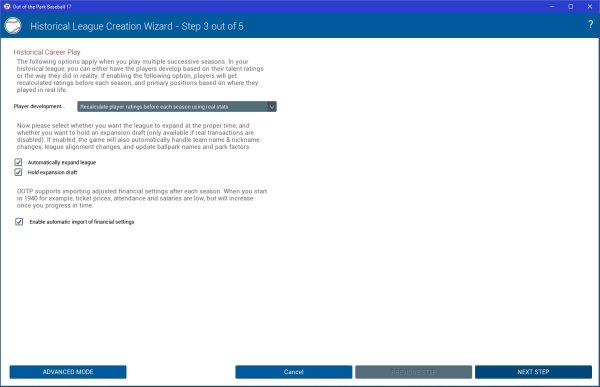
First, define whether you want the game to recalcuate player ratings before each season based on their real-life statistics. Alternately, you can leave things up to OOTP's engine, or you can disable player development entirely, if you wish to do a complete replay of the historical season.
Next, decide whether you want to automatically expand the league and hold an expansion draft.
Finally, decide whether you want to enable the automatic import of financial settings.
When you are done, click Next Step.
Step 4 - Scouting, Ratings Scale, and FaceGen
In Step 4 of the Historical League Creation Wizard, you define settings for scouting system, ratings scale, and the fictional face generator for your league.
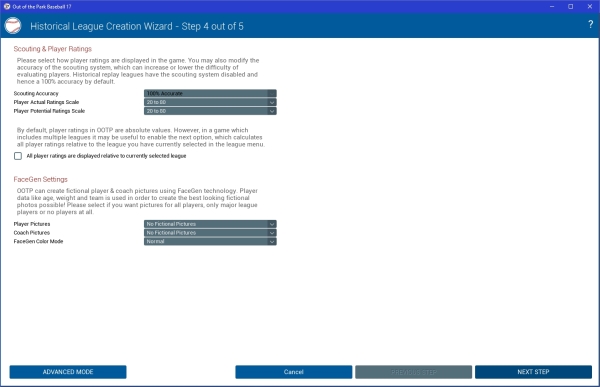
First, you define the accuracy of the scouting system (assuming the league is non-historical), the type of numerical scale used to display ratings and potentials, and whether or not the ratings you see are absolute values or are relative to the league currently selected in the League Menu.
You can also specify which players and staff members have pictures created for them using FaceGen technology, and how those pictures should be colored. When you are done, click Next Step.
Step 5 - Universe, Profile, Play Mode, and Team Selection
In Step 5 of the Historical League Creation Wizard, you make some final decisions about how your league is set up.
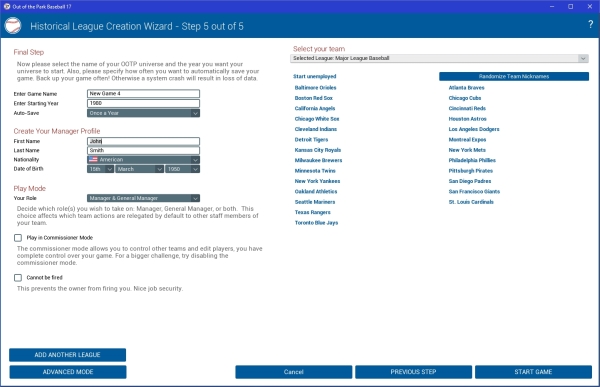
First, decide on a name for your game and the starting year for your game. You can also decide how often the game will save automatically - daily, weekly, monthly, or yearly.
Then, select a name, nationality, and birth date for your manager.
Next, decide whether or not to play in Commissioner Mode. If the Play in Commissioner Mode check box is selected, this manager is also the commissioner and has the ability to interact with the game in many ways that managers can't. You can also choose to act only as a General Manager, in which case on-field management will be handled by your manager, and whether or not you cannot be fired.
Finally, select a team to manage. During league creation, you can choose to manage any team in your league. You can choose to start unemployed, but be careful - once you start the game, you are at the mercy of team owners, who might not want to hire a greenhorn like you! Read more about human manager identities in OOTP for more information.
When you are done, click Start Game! OOTP will process all the information you have selected and drop you onto the Manager Home Screen screen. If you want to add more leagues into this world, you can do so through the Game Setup option (Game menu >> Advanced section >> Setup and Options).